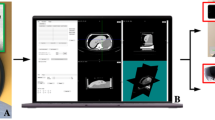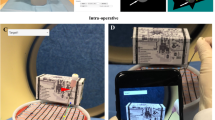Abstract
Purpose
To compare needle placement performance using an augmented reality (AR) navigation platform implemented on smartphone or smartglasses devices to that of CBCT-guided fluoroscopy in a phantom.
Materials and Methods
An AR application was developed to display a planned percutaneous needle trajectory on the smartphone (iPhone7) and smartglasses (HoloLens1) devices in real time. Two AR-guided needle placement systems and CBCT-guided fluoroscopy with navigation software (XperGuide, Philips) were compared using an anthropomorphic phantom (CIRS, Norfolk, VA). Six interventional radiologists each performed 18 independent needle placements using smartphone (n = 6), smartglasses (n = 6), and XperGuide (n = 6) guidance. Placement error was defined as the distance from the needle tip to the target center. Placement time was recorded. For XperGuide, dose-area product (DAP, mGy*cm2) and fluoroscopy time (sec) were recorded. Statistical comparisons were made using a two-way repeated measures ANOVA.
Results
The placement error using the smartphone, smartglasses, or XperGuide was similar (3.98 ± 1.68 mm, 5.18 ± 3.84 mm, 4.13 ± 2.38 mm, respectively, p = 0.11). Compared to CBCT-guided fluoroscopy, the smartphone and smartglasses reduced placement time by 38% (p = 0.02) and 55% (p = 0.001), respectively. The DAP for insertion using XperGuide was 3086 ± 2920 mGy*cm2, and no intra-procedural radiation was required for augmented reality.
Conclusions
Smartphone- and smartglasses-based augmented reality reduced needle placement time and radiation exposure while maintaining placement accuracy compared to a clinically validated needle navigation platform.





Similar content being viewed by others
References
Racadio JM, Babic D, Homan R, Rampton JW, Patel MN, Racadio JM, et al. Live 3D guidance in the interventional radiology suite. AJR Am J Roentgenol. 2007;189(6):W357–64.
Busser WM, Braak SJ, Futterer JJ, van Strijen MJ, Hoogeveen YL, de Lange F, et al. Cone beam CT guidance provides superior accuracy for complex needle paths compared with CT guidance. Br J Radiol. 2013;86(1030):20130310.
Floridi C, Reginelli A, Capasso R, Fumarola E, Pesapane F, Barile A, et al. Percutaneous needle biopsy of mediastinal masses under C-arm conebeam CT guidance: diagnostic performance and safety. Med Oncol. 2017;34(4):67.
Fior D, Vacirca F, Leni D, Pagni F, Ippolito D, Riva L, et al. Virtual guidance of percutaneous transthoracic needle biopsy with C-arm cone-beam CT: diagnostic accuracy, risk factors and effective radiation dose. Cardiovasc Intervent Radiol. 2019;42(5):712–9.
Braak SJ, van Strijen MJ, van Leersum M, van Es HW, van Heesewijk JP. Real-Time 3D fluoroscopy guidance during needle interventions: technique, accuracy, and feasibility. AJR Am J Roentgenol. 2010;194(5):W445–51.
Ahn SY, Park CM, Yoon SH, Kim H, Goo JM. Learning curve of C-arm cone-beam computed tomography virtual navigation-guided percutaneous transthoracic needle biopsy. Korean J Radiol. 2019;20(5):844–53.
Wood BJ, Locklin JK, Viswanathan A, Kruecker J, Haemmerich D, Cebral J, et al. Technologies for guidance of radiofrequency ablation in the multimodality interventional suite of the future. J Vasc Interv Radiol. 2007;18(1 Pt 1):9–24.
Park BJ, Hunt SJ, Martin C, Nadolski GJ, Wood BJ, Gade TP. Augmented and mixed reality: technologies for enhancing the future of IR. J Vasc Interv Radiol. 2020;31:1074–82.
Uppot RN, Laguna B, McCarthy CJ, De Novi G, Phelps A, Siegel E, et al. Implementing virtual and augmented reality tools for radiology education and training, communication, and clinical care. Radiology. 2019;291(3):570–80.
Kenngott HG, Preukschas AA, Wagner M, Nickel F, Muller M, Bellemann N, et al. Mobile, real-time, and point-of-care augmented reality is robust, accurate, and feasible: a prospective pilot study. Surg Endosc. 2018;32(6):2958–67.
Heinrich F, Joeres F, Lawonn K, Hansen C. Comparison of projective augmented reality concepts to support medical needle insertion. IEEE Trans Vis Comput Graph. 2019;25(6):2157–67.
Solbiati M, Passera KM, Rotilio A, Oliva F, Marre I, Goldberg SN, et al. Augmented reality for interventional oncology: proof-of-concept study of a novel high-end guidance system platform. Eur Radiol Exp. 2018;2:18.
Elsayed M, Kadom N, Ghobadi C, Strauss B, Al Dandan O, Aggarwal A, et al. Virtual and augmented reality: potential applications in radiology. Acta Radiol. 2020. https://doi.org/10.1177/0284185119897362.
Pratt P, Ives M, Lawton G, Simmons J, Radev N, Spyropoulou L, et al. Through the HoloLens looking glass: augmented reality for extremity reconstruction surgery using 3D vascular models with perforating vessels. Eur Radiol Exp. 2018;2(1):2.
Barsom EZ, Graafland M, Schijven MP. Systematic review on the effectiveness of augmented reality applications in medical training. Surg Endosc. 2016;30(10):4174–83.
Li M, Seifabadi R, Long D, De Ruiter Q, Varble N, Hecht R, et al. Smartphone- versus smartglasses-based augmented reality (AR) for percutaneous needle interventions: system accuracy and feasibility study. Int J Computer Assist Radiol Surg. 2020;15:1921–30.
Hecht R, Li M, de Ruiter QMB, Pritchard WF, Li X, Krishnasamy V, et al. Smartphone augmented reality CT-based platform for needle insertion guidance: a phantom study. Cardiovasc Intervent Radiol. 2020;43:756–64.
Vovk A, Wild F, Guest W, Kuula T, editors. Simulator Sickness in Augmented Reality Training Using the Microsoft HoloLens. Conference on Human Factors in Computing Systems; 2018; Montreal, Canada. New York, NY United States: Association for Computing Machinery, New York, NY; 2018.
Rebenitsch L, Owen C. Review on cybersickness in applications and visual displays. Virtual Real. 2016;20(2):101–35.
Racadio JM, et al. Augmented reality on a C-arm system: a preclinical assessment for percutaneous needle localization. Radiology. 2016;281:249–55.
Nicolau SA, Pennec X, Soler L, Buy X, Gangi A, Ayache N, et al. An augmented reality system for liver thermal ablation: design and evaluation on clinical cases. Med Image Anal. 2009;13(3):494–506.
Fichtinger G, Deguet A, Masamune K, Balogh E, Fischer GS, Mathieu H, et al. Image overlay guidance for needle insertion in CT scanner. IEEE Trans Biomed Eng. 2005;52(8):1415–24.
Si W, Liao X, Qian Y, Wang Q. Mixed reality guided radiofrequency needle placement: a pilot study. IEEE Access. 2018;6:31493–502.
Lin MA, Siu AF, Bae JH, Cutkosky MR, Daniel BL. HoloNeedle: augmented reality guidance system for needle placement investigating the advantages of three-dimensional needle shape reconstruction. IEEE Robot Autom Lett. 2018;3(4):4156–62.
Funding
This work was supported by the Center for Interventional Oncology in the Intramural Research Program of the National Institutes of Health (NIH) by intramural NIH Grants NIH Z01 1ZID BC011242 and CL040015.
Author information
Authors and Affiliations
Corresponding author
Ethics declarations
Conflict of interest
NIH has a Cooperative Research and Development Agreements with Philips Research, Celsion Corp, Biocompatibles UK Ltd–Boston Scientific Corporation, Siemens Medical Solutions, NVIDIA, and XAct Robotics. None of these entities were involved in the reported work. NV is an employee of Philips Research North America. The content of this manuscript does not necessarily reflect the views, policies, or opinions of the U.S. Department of Health and Human Services. The mention of commercial products, their source, or their use in connection with material reported herein is not to be construed as an actual or implied endorsement of such products by the United States Government. Opinions expressed are those of the authors, not necessarily the NIH.
Ethical Approval
This article does not contain any studies with human participants or animals performed by any of the authors.
Informed Consent
For this type of study, informed consent is not required.
Consent for Publication
For this type of study, consent for publication is not required.
Additional information
Publisher's Note
Springer Nature remains neutral with regard to jurisdictional claims in published maps and institutional affiliations.
Rights and permissions
About this article
Cite this article
Long, D.J., Li, M., De Ruiter, Q.M.B. et al. Comparison of Smartphone Augmented Reality, Smartglasses Augmented Reality, and 3D CBCT-guided Fluoroscopy Navigation for Percutaneous Needle Insertion: A Phantom Study. Cardiovasc Intervent Radiol 44, 774–781 (2021). https://doi.org/10.1007/s00270-020-02760-7
Received:
Accepted:
Published:
Issue Date:
DOI: https://doi.org/10.1007/s00270-020-02760-7




